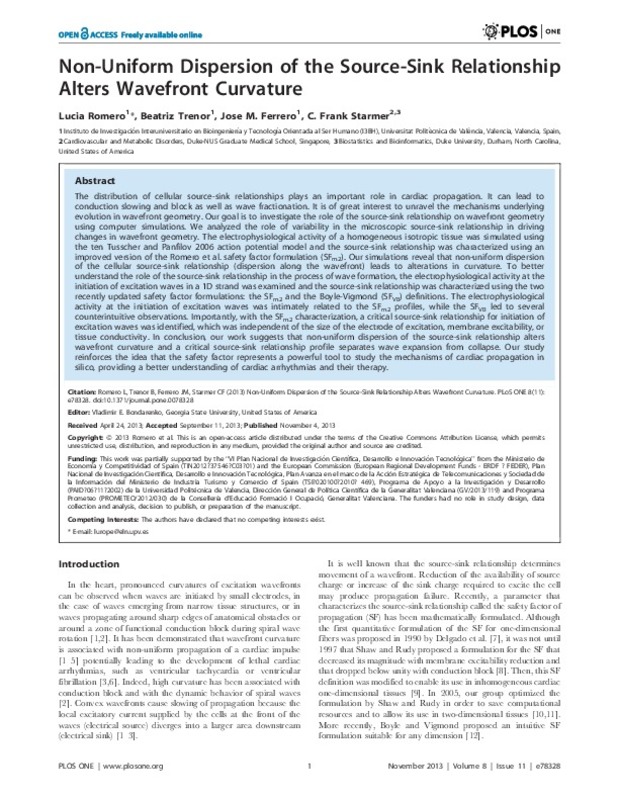Cabo, C., Pertsov, A. M., Baxter, W. T., Davidenko, J. M., Gray, R. A., & Jalife, J. (1994). Wave-front curvature as a cause of slow conduction and block in isolated cardiac muscle. Circulation Research, 75(6), 1014-1028. doi:10.1161/01.res.75.6.1014
Fast, V. G., & Kléber, A. G. (1997). Role of wavefront curvature in propagation of cardiac impulse. Cardiovascular Research, 33(2), 258-271. doi:10.1016/s0008-6363(96)00216-7
KLÉBER, A. G., & RUDY, Y. (2004). Basic Mechanisms of Cardiac Impulse Propagation and Associated Arrhythmias. Physiological Reviews, 84(2), 431-488. doi:10.1152/physrev.00025.2003
[+]
Cabo, C., Pertsov, A. M., Baxter, W. T., Davidenko, J. M., Gray, R. A., & Jalife, J. (1994). Wave-front curvature as a cause of slow conduction and block in isolated cardiac muscle. Circulation Research, 75(6), 1014-1028. doi:10.1161/01.res.75.6.1014
Fast, V. G., & Kléber, A. G. (1997). Role of wavefront curvature in propagation of cardiac impulse. Cardiovascular Research, 33(2), 258-271. doi:10.1016/s0008-6363(96)00216-7
KLÉBER, A. G., & RUDY, Y. (2004). Basic Mechanisms of Cardiac Impulse Propagation and Associated Arrhythmias. Physiological Reviews, 84(2), 431-488. doi:10.1152/physrev.00025.2003
Wellner, M., & Pertsov, A. M. (1997). Generalized eikonal equation in excitable media. Physical Review E, 55(6), 7656-7661. doi:10.1103/physreve.55.7656
Vaquero, M., Calvo, D., & Jalife, J. (2008). Cardiac fibrillation: From ion channels to rotors in the human heart. Heart Rhythm, 5(6), 872-879. doi:10.1016/j.hrthm.2008.02.034
Delgado, C., Steinhaus, B., Delmar, M., Chialvo, D. R., & Jalife, J. (1990). Directional differences in excitability and margin of safety for propagation in sheep ventricular epicardial muscle. Circulation Research, 67(1), 97-110. doi:10.1161/01.res.67.1.97
Shaw, R. M., & Rudy, Y. (1997). Ionic Mechanisms of Propagation in Cardiac Tissue. Circulation Research, 81(5), 727-741. doi:10.1161/01.res.81.5.727
Wang, Y., & Rudy, Y. (2000). Action potential propagation in inhomogeneous cardiac tissue: safety factor considerations and ionic mechanism. American Journal of Physiology-Heart and Circulatory Physiology, 278(4), H1019-H1029. doi:10.1152/ajpheart.2000.278.4.h1019
Romero, L., Trénor, B., Alonso, J. M., Tobón, C., Saiz, J., & Ferrero, J. M. (2009). The Relative Role of Refractoriness and Source–Sink Relationship in Reentry Generation during Simulated Acute Ischemia. Annals of Biomedical Engineering, 37(8), 1560-1571. doi:10.1007/s10439-009-9721-2
Boyle, P. M., & Vigmond, E. J. (2010). An Intuitive Safety Factor for Cardiac Propagation. Biophysical Journal, 98(12), L57-L59. doi:10.1016/j.bpj.2010.03.018
Kucera, J. P., & Rudy, Y. (2001). Mechanistic Insights Into Very Slow Conduction in Branching Cardiac Tissue. Circulation Research, 89(9), 799-806. doi:10.1161/hh2101.098442
Azene, E. M., Trayanova, N. A., & Warman, E. (2001). Wave Front–Obstacle Interactions in Cardiac Tissue: A Computational Study. Annals of Biomedical Engineering, 29(1), 35-46. doi:10.1114/1.1332083
Aslanidi, O. V., Stewart, P., Boyett, M. R., & Zhang, H. (2009). Optimal Velocity and Safety of Discontinuous Conduction through the Heterogeneous Purkinje-Ventricular Junction. Biophysical Journal, 97(1), 20-39. doi:10.1016/j.bpj.2009.03.061
Hubbard, M. L., & Henriquez, C. S. (2010). Increased interstitial loading reduces the effect of microstructural variations in cardiac tissue. American Journal of Physiology-Heart and Circulatory Physiology, 298(4), H1209-H1218. doi:10.1152/ajpheart.00689.2009
Ten Tusscher, K. H. W. J., & Panfilov, A. V. (2006). Alternans and spiral breakup in a human ventricular tissue model. American Journal of Physiology-Heart and Circulatory Physiology, 291(3), H1088-H1100. doi:10.1152/ajpheart.00109.2006
Van Capelle, F. J., & Durrer, D. (1980). Computer simulation of arrhythmias in a network of coupled excitable elements. Circulation Research, 47(3), 454-466. doi:10.1161/01.res.47.3.454
STARMER, C. F. (1997). The Cardiac Vulnerable Period and Reentrant Arrhythmias: Targets of Anti- and Proarrhythmic Processes. Pacing and Clinical Electrophysiology, 20(2), 445-454. doi:10.1111/j.1540-8159.1997.tb06203.x
Starmer, C. (2003). What happens when cardiac Na channels lose their function? 1 – Numerical studies of the vulnerable period in tissue expressing mutant channels. Cardiovascular Research, 57(1), 82-91. doi:10.1016/s0008-6363(02)00613-2
Allessie, M. A., Bonke, F. I., & Schopman, F. J. (1976). Circus movement in rabbit atrial muscle as a mechanism of tachycardia. II. The role of nonuniform recovery of excitability in the occurrence of unidirectional block, as studied with multiple microelectrodes. Circulation Research, 39(2), 168-177. doi:10.1161/01.res.39.2.168
HAN, J., & MOE, G. K. (1964). Nonuniform Recovery of Excitability in Ventricular Muscle. Circulation Research, 14(1), 44-60. doi:10.1161/01.res.14.1.44
Clayton, R. H., & Holden, A. V. (2005). BioMedical Engineering OnLine, 4(1), 11. doi:10.1186/1475-925x-4-11
ZHAO, J., TREW, M. L., LEGRICE, I. J., SMAILL, B. H., & PULLAN, A. J. (2009). A Tissue-Specific Model of Reentry in the Right Atrial Appendage. Journal of Cardiovascular Electrophysiology, 20(6), 675-684. doi:10.1111/j.1540-8167.2008.01420.x
Ong, J. J., Cha, Y. M., Kriett, J. M., Boyce, K., Feld, G. K., & Chen, P. S. (1995). The relation between atrial fibrillation wavefront characteristics and accessory pathway conduction. Journal of Clinical Investigation, 96(5), 2284-2296. doi:10.1172/jci118284
DANSE, P. W., GARRATT, C. J., MAST, F., & ALLESSIE, M. A. (2000). Preferential Depression of Conduction Around a Pivot Point in Rabbit Ventricular Myocardium by Potassium and Flecainide. Journal of Cardiovascular Electrophysiology, 11(3), 262-273. doi:10.1111/j.1540-8167.2000.tb01795.x
Stein, M., van Veen, T. A. B., Hauer, R. N. W., de Bakker, J. M. T., & van Rijen, H. V. M. (2011). A 50% Reduction of Excitability but Not of Intercellular Coupling Affects Conduction Velocity Restitution and Activation Delay in the Mouse Heart. PLoS ONE, 6(6), e20310. doi:10.1371/journal.pone.0020310
Leon, L. J., & Roberge, F. A. (1991). Directional characteristics of action potential propagation in cardiac muscle. A model study. Circulation Research, 69(2), 378-395. doi:10.1161/01.res.69.2.378
Faber, G. M., & Rudy, Y. (2000). Action Potential and Contractility Changes in [Na+]i Overloaded Cardiac Myocytes: A Simulation Study. Biophysical Journal, 78(5), 2392-2404. doi:10.1016/s0006-3495(00)76783-x
Spach, M. S., Miller, W. T., Geselowitz, D. B., Barr, R. C., Kootsey, J. M., & Johnson, E. A. (1981). The discontinuous nature of propagation in normal canine cardiac muscle. Evidence for recurrent discontinuities of intracellular resistance that affect the membrane currents. Circulation Research, 48(1), 39-54. doi:10.1161/01.res.48.1.39
EFIMOV, I. R., CHENG, Y. N., BIERMANN, M., WAGONER, D. R., MAZGALEV, T. N., & TCHOU, P. J. (1997). Transmembrane Voltage Changes Produced by Real and Virtual Electrodes During Monophasic Defibrillation Shock Delivered by an Implantable Electrode. Journal of Cardiovascular Electrophysiology, 8(9), 1031-1045. doi:10.1111/j.1540-8167.1997.tb00627.x
Sambelashvili, A. T., Nikolski, V. P., & Efimov, I. R. (2003). Nonlinear effects in subthreshold virtual electrode polarization. American Journal of Physiology-Heart and Circulatory Physiology, 284(6), H2368-H2374. doi:10.1152/ajpheart.00988.2002
[-]









